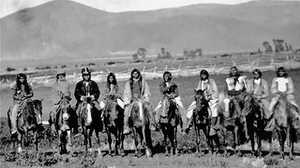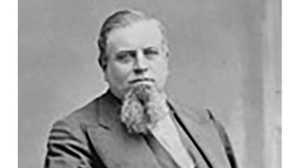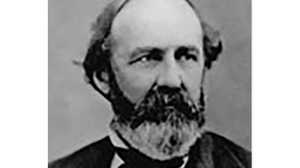The Race to Utah
The Central Pacific and Union Pacific railroads vied to establish routes across the territory from western Iowa to northern California in a bitter contest. The Pacific Railroad acts of 1862 and 1864 granted land and government bonds to the companies on the basis of how many miles of track they laid, setting the stage for a wild seven-year race.
Hard Work, Big Rewards
While the Central Pacific labored eastward in the mountains of the Sierra Nevada, the Union Pacific built more rapidly westward across Nebraska and Wyoming. The Associates, as the Central Pacific directors called themselves, were steadfast in their aim -- they wanted their efforts to earn them more than mere existence as a Union Pacific feeder route through California. So they pushed their crews east, intent on grabbing as much land as possible. Mileage meant money, power, and a fantastic business opportunity. Whichever line neared Salt Lake City, Utah first assured Mormon traffic on its route. That line that built through Utah's Weber Canyon, east of Ogden, possessed its coal mines -- a rich source of wealth and fuel. In April 1868, as the Central Pacific entered Nevada, UP executive Thomas C. Durant telegraphed CP head Leland Stanford to inform him that the Union Pacific had surmounted the Rockies. Stanford ironically replied, "May your descent be easy and rapid."
A Secret Deal
In September 1868, the Central Pacific learned that Union Pacific grading crews were almost through Echo Canyon, Utah, the last barrier before Weber. Soon the Union Pacific would lay its line in the coal fields. Moreover, the competitors now worked the same stretch of Utah desert, grading for two tracks where only one would ultimately be laid. On the 29th, Central Pacific crews passed a landmark that allowed CP executive Collis P. Huntington to unleash his strategy. Now within 300 miles of Monument Point, Huntington could legally petition Secretary of the Interior Orville Browning for an extension of the Central Pacific line to Echo Canyon — over the Union Pacific's grade. Constant pressure on the secretary and misrepresentation of construction progress won Huntington his approval. Browning furthermore promised he would keep the decision secret. "By God, Charley, you must work as a man has never worked before," he wrote his associate, Charles Crocker. To Stanford he wired, "Go and see him!" It was a coded order to unleash men across 500 miles of desert to cover the proposed line.
An Embarrassed Retreat
Stanford, supervising in Utah in his typical uncommunicative fashion, did not think it prudent. So he did nothing. The Union Pacific was entrenched toward Echo Canyon, and advance Union Pacific crews now graded on the proposed line. "They are all over our line," he complained. "Often on or across." Huntington grew furious at Stanford, although the latter invited him to Utah to prove Weber had been lost. Huntington reset his sites on Ogden. On December 3, 1868, Browning informed the Union Pacific of his decision. UP chief engineer Grenville Dodge exploded. The Central Pacific had greatly exaggerated its progress, and was now "pretending to lay grade on the same or very nearly same grade that ours is now building upon." Dodge had friends from his army days, including Ulysses S. Grant, who would become president in January. The engineer unleashed a very public war upon Browning. Under increased scrutiny from press and peers, the secretary retreated from his earlier decision. He declared the government would go over both roads to determine an appropriate meeting point.
Fight to the Finish
Dodge's victory put the railroads in a new pickle. Shoddy construction work had been approved by both sides in the race to extend across Utah. And if the Central Pacific was cash-strapped, the Union Pacific was practically broke. Business practices of the latter had come under recent scrutiny from the press. Government examination threatened to ruin both enterprises. Suddenly it seemed advantageous for the railroads to reach an agreement themselves. On January 30, 1869, Congressman and UP ally Oakes Ames and Dodge met Huntington. They proposed convergence halfway between the completed tracks. Huntington replied, "I'll see you damned first." He was determined to attain more land. Plus, as Dodge soon learned, Huntington had secured bonds to Ogden before the close of the previous administration; the Central Pacific held ownership of that town. Dodge and Huntington met again on the evening of April 8, arguing through the night. They resumed in the morning and negotiated late into the evening. Huntington agreed to meet west of Ogden at Promontory Summit. Dodge conceded that the Union Pacific would turn over its road between Promontory and Ogden at full cost. The compromise upset Dodge's compatriots but was welcomed by Congress. Grateful to have the matter resolved, the legislature passed a special resolution approving the decision the next day. The railroads met at Promontory Summit on May 10, 1869.







